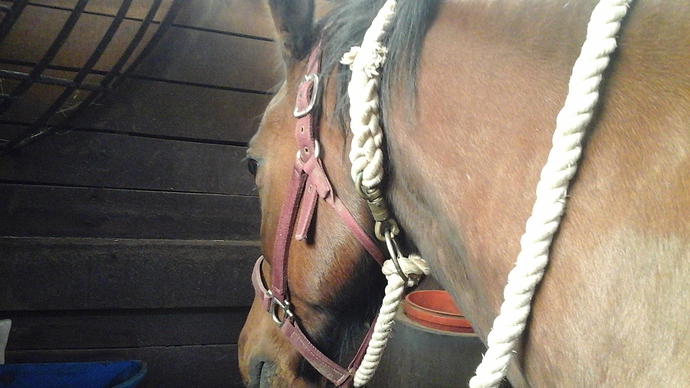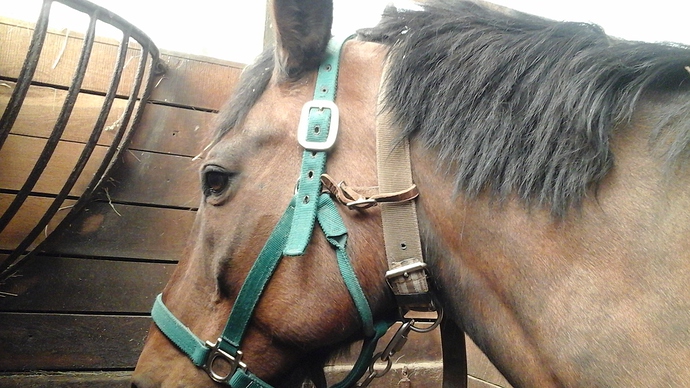Hello, new here. I read a very old thread where “goodhors” talks about tying horses with a neck rope. I’m interested in getting more information on how to correctly and safely do this. I have a horse who has a terrible habit of pulling back. I’d like to use this as a secondary tying option. I’m familiar with the tie rings and these definitely have their place but in our situation there are times when she needs to be hard tied.
Does anyone have information on where to purchase these neck ropes? Or equipment needed and maybe pics on how to make one. Do the snaps fail like with traditional lead ropes? All I can find online are the nylon? neck ropes people use on show steers. Thanks!
I would never tie a horse known for setting back hard. You need to do some training first.
What situations are you talking about? There are other options, even if they’re a bit of a PITA.
We’ve done quite a bit of ground work and will give to pressure when I’m the one asking.
We’re wanting to take her out on overnight pack trips where she needs to be tied. She hobbles, but in these areas that is not an option. The tie ring she knows she can pull it through
Use a longer rope on the tie ring in your training. If she’s pulling it through consistently, you’ve done the training wrong.
FWIW - I have a 100 foot yacht line in a tote in my loft, that sticks around for this exact reason. I’ve never had to use it, but came too close for comfort a couple times with a horse who would occasionally set back. My “training” lead is 14’, and she was a foot from getting it off the tie ring, twice. I ordered the 100’ rope after the second time, and that 100’ rope would be the only thing she would be tied with until the problem was resolved. Thankfully she came around.
I’ve thought of just getting longer ropes, but how can you trust them overnight though?
This is not a horse I’d tie up overnight. Can you bring temp fencing to make a small corral?
You do the work at home where they quit trying to get free because they haven’t succeeded. You have allowed her to succeed. If that’s happened enough times, you may never be able to tie her successfully without her trying to escape.
@Demerara_Stables mentioned one of the other options, which will be a big PITA for pack-camping.
The bottom line is - this might not be a horse you can pack camp with. Can you not sideline hobble with a front leg hobble additional? She won’t make it far.
Thank you for all your insight. You’re right unfortunately she just may not be able to go 
I admittedly know nothing about pack camping, but are the small plastic posts with electric tape too much for that?
I don’t know their pack set up. If they have dedicated pack animals, maybe not, but if they’re trying to carry only the essentials on the animals they are riding, I would say yes.
Having seen what happens to a dairy cow snubbed with a collar accidentally, I would never purposely hard tie a horse with a collar. You’re asking for throat damage or worse for a horse that is married to the practice of pulling back when tied.
If you absolutely must hard tie your horse, it’s time to pass this horse on to someone that doesn’t need to do so and get yourself one that is happy to stand tied.
You can highline if trees are available but that’s not without risk. I’d rather pack in hot tape, posts and a solar charger. We did that with @OnAMission in the Bob and that was the least stressful. We also mixed in hobbling some or highlining some.
Hard tying with a neck rope won’t work for the horse that sits back. Maybe you highline everyone else and leave her hobbled. She won’t leave the crew.
Agree. The only way I would ever tie a horse whilst camping is with a highline, alongside experienced old souls. You can also install a higline at home for practice. Learn your knots and bring a knife. A highline allows their feet to move; it can be useful to teach patience. Otherwise tape and stakes, and again, alongside experienced, quiet horses.
You might see if there is a Back County Horsemen group in your area. They often hold clinics and introductory camp trips and offer a wealth of knowledge.
Could you hobble and do a leg picket?
Stumbled on this, saw my name! The cow collar and neck rope are both good for tying the horse because they transfer the pull back farther on the muscled neck, rather than the spine/skull joint where halter crown falls.
When I tie a horse, he WILL be there when I come back. I use a nylon halter and cotton lead with heavy snaps and ring. Usually a bull snap or a barrel quick-release snap because they can take the jerk weight of horse.
First photo is a neck rope, cotton with barrel quick-release snap. Twist barrel and snap opens despite any hard pull on rope… Second photo is a cow collar attached to halter, has a heavy snap plus cotton rope. We use one inch cotton rope, back braid in the snap preferred. I start with about 14ft of rope. I hold the snap end and wrap the rope around horse neck to figure ring location, then tie ring in. Cotton rope this thick is very strong, LESS likely to burn a horse or person when pulled upon, like can happen with any of the synthetic ropes.
Neck collar use is fairly recent, 15 years or so. I never use the cow collar alone, always with a sturdy nylon halter… I want horse head aimed at where he is tied for a direct pull of his head and neck. Less likely to get injured if not pulled sideways or actually pull the collar off over his head!
I have never used the blocker rings, horses here are too smart about figuring how they work and get loose. Watched one learn that game with a 12ft rope at the trainers. Not going to tie with a long rope to get tangled in his feet as he works his way loose. May take time, but they will get loose.
Ours are taught to tie hard and fast in training. Always tied with the neck rope or cow collar during ‘learning time.’ Before tying they are taught to “give to pressure,” rewarded with pressure release. They KNOW how to move forward if rope tightens on them. This learning doesn’t happen in a day or a week.
If horse is already a confirmed puller, it will take a while to get him to move forward as his FIRST response instead of flying backwards when the rope gets tight. There are other methods, not cruel, don’t abuse him, but it can get exciting until horse figures out to move forward into the tight rope tie.
You do have to have something that will hold him regardless of what he does. If things break, it will teach him that fighting harder WILL get him free of this scary restraint!! You may want to hire a good cowboy for that.
We only owned one TB that didn’t tie. He was not here very long.
The horse wearing the cow collar is always itchy. He learned how to rub off his halter AND neck rope!! We now tie him with the pictured set-up to ensure he STAYS tied. Sometimes his halter crown is over his eyes when we come back. But most important is that he is still where we left him!! He has always enjoyed being rubbed, has a thick mane. No skin issues, just something to do when tied and bored.
This is such an important concept that it bears repeating. Yes, there are places and times to have breakaway cross/single ties, but if I’ve got one that likes to break them, those go away and they learn how to hard tie. Allowing a horse to pull back and break something in the name of safety isn’t safe - it’s creating a horse that you can’t trust too stand where you put it.
@goodhors thank you for responding! The pictures are very helpful. I generally use a rope halter, will this still work? I also just switched to an attached lead rope to have less hardware to break. In your experience does the hardware on the neck rope or collar break as easy?
Better make sure your rope halter fits REALLY well because when they set back it will stretch and it can end up in their mouth. That’s no good.
@Demerara_Stables tying something that doesn’t want to tie hard and solid is a good way to hurt them, imo. That’s why I like the blocker rings. They aren’t leaving, nothing will break, they don’t get the reward, but they also don’t damage themselves learning that.
personally, I wouldn’t tie this horse “hard and fast” if it’s a flyback. If you’re tying them with something that’s not going to give, they’re going to injure themselves in the neck/poll trying.


